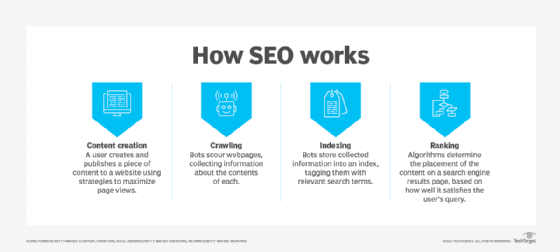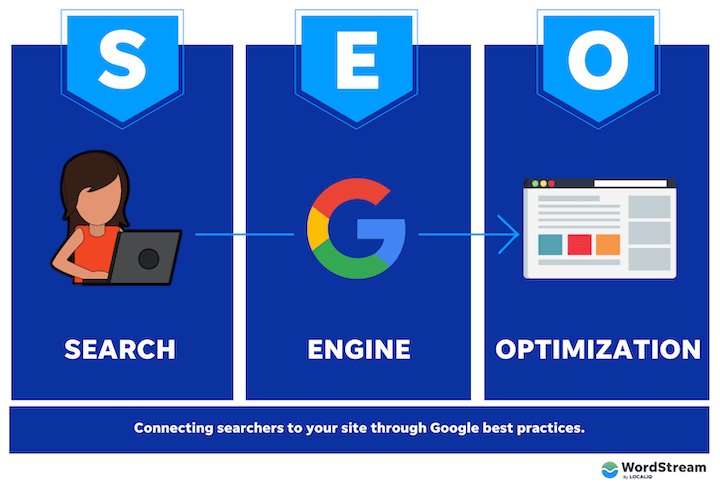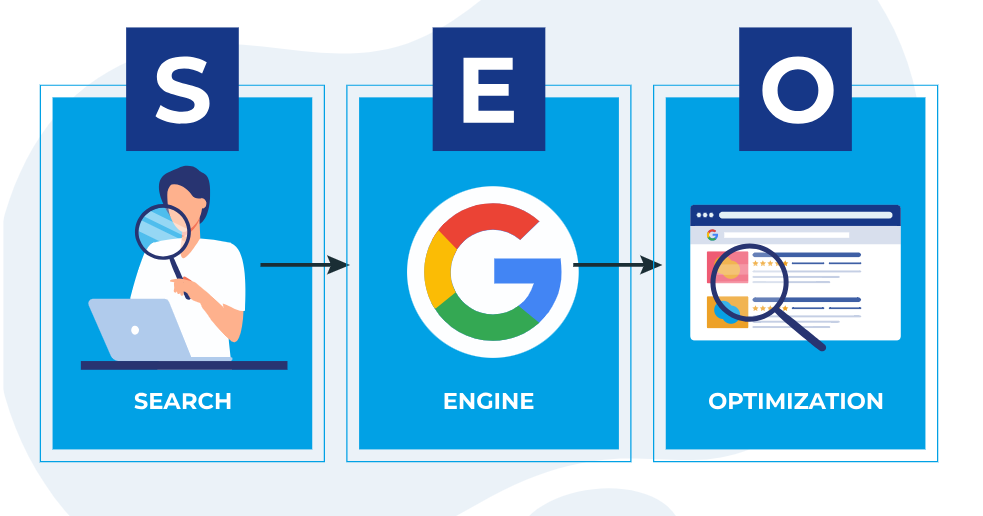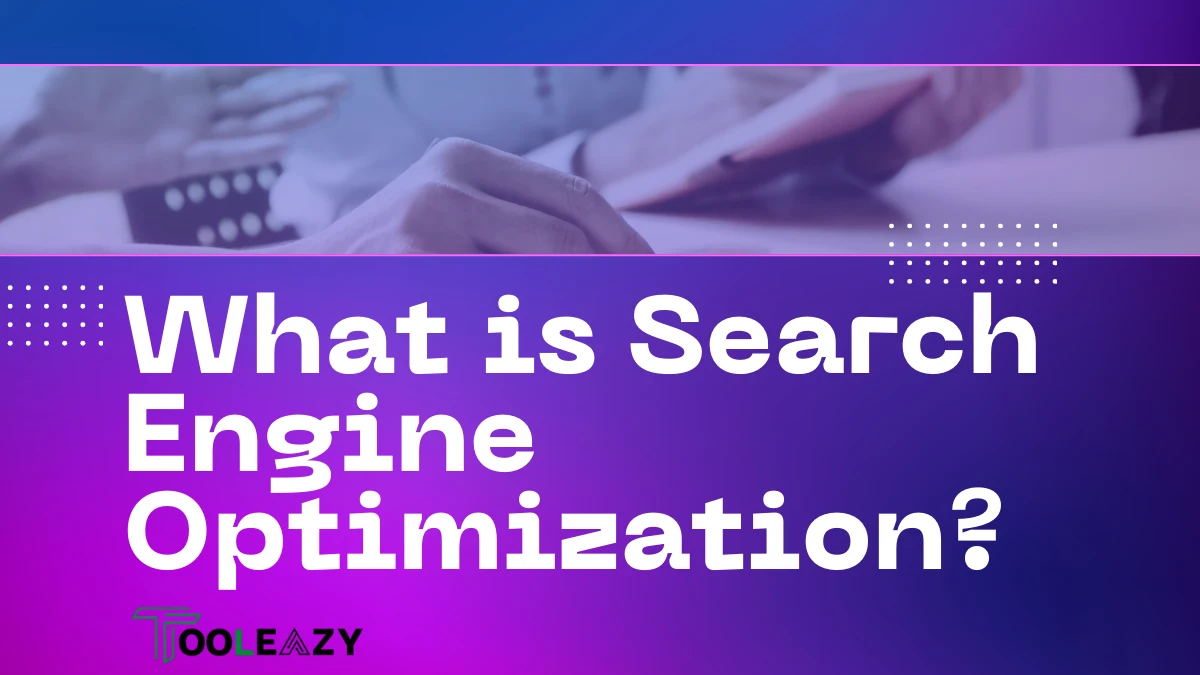Search Engine Optimization (SEO) is about improving a website’s visibility on search engines like Google. It helps websites rank higher in search results, attracting more visitors.
Imagine you have a store on a busy street. SEO makes sure your store stands out so people notice it. In the digital world, SEO does the same for your website. It uses techniques like keyword research, content optimization, and link building.
The goal is to make your site more appealing to search engines. This means better rankings and more traffic. Understanding SEO can seem tricky at first, but it’s essential for online success. Let’s dive into the basics of SEO and why it matters.

Credit: www.techtarget.com
Table of Contents
ToggleKey Components Of Seo
Search Engine Optimization, or SEO, is the practice of enhancing a website to improve its visibility on search engines like Google. The goal is to attract more organic traffic by achieving higher search engine rankings. SEO involves multiple strategies and techniques, which are broadly categorized into three key components: On-Page SEO, Off-Page SEO, and Technical SEO.
On-page Seo
On-Page SEO refers to the optimization of individual web pages to rank higher and earn more relevant traffic. This component focuses on both the content and the HTML source code of a page. Key elements of On-Page SEO include:
- Keyword Research: Identifying the right keywords to target is crucial. Use tools like SEMrush & Ahrefs to find keywords that have high search volume and low competition.
- Content Marketing: Creating valuable, high-quality content that meets the needs of your audience. Content should be engaging and relevant.
- Meta Tags: Optimizing meta titles and descriptions to include target keywords. This helps search engines understand the content of your page.
- Header Tags: Using H1, H2, and H3 tags to structure your content. This makes it easier for both users and search engines to read.
- Internal Linking: Linking to other relevant pages on your site helps search engines crawl your site more effectively.
Here’s a quick reference table for On-Page SEO elements:
| Element | Description |
|---|---|
| Keyword Research | Finding relevant keywords to target |
| Content Marketing | Creating high-quality, engaging content |
| Meta Tags | Optimizing titles and descriptions |
| Header Tags | Structuring content with H1, H2, H3 tags |
| Internal Linking | Linking to other relevant pages |
Off-page Seo
Off-Page SEO involves activities that take place outside your website to improve its search engine ranking. These activities help build the site’s reputation and authority. Key aspects of Off-Page SEO include:
- Backlink Building: Acquiring high-quality backlinks from reputable websites. Backlinks act as votes of confidence for your site.
- Social Media Marketing: Promoting your content on social media platforms to increase visibility and attract traffic.
- Guest Blogging: Writing articles for other websites in your industry. This helps you gain exposure and backlinks.
- Influencer Outreach: Partnering with influencers to promote your content. Influencers can help you reach a wider audience.
- Online Reviews: Encouraging satisfied customers to leave positive reviews. Reviews impact your online reputation.
Here are some common Off-Page SEO strategies:
| Strategy | Description |
|---|---|
| Backlink Building | Acquiring high-quality backlinks |
| Social Media Marketing | Promoting content on social media |
| Guest Blogging | Writing articles for other websites |
| Influencer Outreach | Partnering with influencers |
| Online Reviews | Encouraging positive customer reviews |
Technical Seo
Technical SEO focuses on optimizing the technical aspects of a website to improve its search engine ranking. These optimizations ensure that search engines can crawl and index your site efficiently. Key elements of Technical SEO include:
- Site Speed Optimization: Improving the loading speed of your website. Faster sites provide a better user experience and rank higher.
- Mobile Optimization: Ensuring your website is mobile-friendly. A significant portion of users access the web through mobile devices.
- XML Sitemaps: Creating and submitting an XML sitemap helps search engines understand the structure of your site.
- Robots.txt: Using a robots.txt file to control which pages search engines can crawl.
- Structured Data: Implementing structured data (schema markup) to help search engines understand the content better.
Here’s a quick overview of Technical SEO components:
| Component | Description |
|---|---|
| Site Speed Optimization | Improving website loading speed |
| Mobile Optimization | Ensuring mobile-friendliness |
| XML Sitemaps | Creating and submitting an XML sitemap |
| Robots.txt | Controlling search engine crawling |
| Structured Data | Implementing schema markup |

Credit: vwo.com
Keyword Research
One of the key aspects of SEO is Keyword Research. This process involves finding and analyzing the terms that people enter into search engines. By understanding these keywords, you can optimize your content to attract more organic traffic. This boosts your search engine ranking and overall website visibility.
Finding Keywords
Finding the right keywords is essential for successful SEO. The goal is to identify words and phrases that your target audience is searching for. This involves understanding user intent and ensuring your content matches what they are looking for. Here are some steps to help you find keywords:
- Brainstorm a list of topics related to your business or niche.
- Think about the questions your audience might ask.
- Use search engines to find related search terms.
- Check out your competitors’ websites and see what keywords they are targeting.
Additionally, you can use a table to organize your keyword ideas:
| Keyword | Search Volume | Difficulty |
|---|---|---|
| Backlinking | 5000 | Medium |
| Content Marketing | 12000 | High |
| On-Page SEO | 8000 | Low |
Tools For Keyword Research
There are several tools available that can assist you in keyword research. These tools provide valuable data on search volume, competition, and related keywords. Here are some popular tools:
- Google Keyword Planner: Offers insights into search volume and competition. It is free to use and integrates with Google Ads.
- Ahrefs: Provides in-depth keyword analysis, backlinking data, and content suggestions. It is a paid tool with extensive features.
- SEMrush: Helps with keyword research, SERP optimization, and competitor analysis. It also offers tools for content marketing and search algorithms tracking.
- Ubersuggest: A user-friendly tool that offers keyword suggestions, search volume, and difficulty scores. It is available in both free and paid versions.
Using these tools can help you refine your keyword strategy. They provide data-driven insights that enhance your on-page SEO and overall search engine ranking. This leads to better website visibility and increased organic traffic.
Content Creation
Search Engine Optimization (SEO) involves improving a website to increase its visibility on search engines. Content creation plays a crucial role in this process. Creating quality content helps attract and engage users, leading to higher search engine rankings and more organic traffic. Effective content creation incorporates several key elements, including quality content and content optimization.
Quality Content
Quality content is the backbone of any successful SEO strategy. It ensures that the information provided is valuable, engaging, and relevant to the audience. Here are some essential aspects of creating quality content:
- Research: Conduct thorough keyword research to understand what your audience is searching for. Use tools to find relevant keywords that will help your content rank higher on search engine results pages (SERP).
- Originality: Ensure your content is unique and offers fresh perspectives. Plagiarized or duplicated content can negatively impact your search engine ranking.
- Value: Provide useful information that addresses the needs and questions of your audience. High-value content encourages longer user engagement, improving user experience.
- Readability: Write in a clear, concise manner. Use short sentences and simple language to make your content accessible to a broader audience, including non-native speakers.
- Structure: Organize your content with headings, subheadings, bullet points, and paragraphs. This makes it easier for users to skim and find the information they need.
- Visuals: Include images, infographics, and videos to make your content more engaging. Visual content can help illustrate points and improve user experience.
Content Optimization
Content optimization involves refining your content to make it more search engine-friendly. This process ensures that your content is easily discoverable and ranks higher on search engine results pages. Here are some key elements of content optimization:
- Meta Tags: Use relevant meta tags, such as title tags and meta descriptions, to help search engines understand the content of your page. Meta tags can influence click-through rates from the SERP.
- Keywords: Incorporate keywords naturally throughout your content. Avoid keyword stuffing, which can harm your search engine ranking. Focus on using keywords in headings, subheadings, and within the first 100 words of your content.
- On-Page SEO: Optimize on-page elements like URL structure, image alt text, and internal linking. Proper on-page SEO helps search algorithms index and rank your content more effectively.
- Backlinks: Aim to get quality backlinks from reputable websites. Backlinks signal to search engines that your content is credible and valuable.
- User Experience: Ensure your content is mobile-friendly and loads quickly. A positive user experience can lead to higher search engine rankings.
- Content Marketing: Promote your content through various channels, such as social media and email marketing. Effective content marketing can drive more organic traffic to your site.
Here’s a simple table summarizing some key aspects of content optimization:
| Optimization Element | Description |
|---|---|
| Meta Tags | Tags that describe the content of your page |
| Keywords | Relevant terms used naturally in the content |
| On-Page SEO | Optimizing URL structure, image alt text, internal links |
| Backlinks | Links from reputable websites to your content |
| User Experience | Mobile-friendly, fast-loading content |
| Content Marketing | Promoting content through various channels |
Link Building
Search Engine Optimization (SEO) involves various techniques aimed at improving a website’s visibility on search engines. One critical aspect of SEO is Link Building. Link Building refers to acquiring hyperlinks from other websites to your own. These links act as votes of confidence, signaling to search engines that your content is valuable. Effective Link Building can boost your website’s authority and improve search engine rankings, leading to increased organic traffic.
Types Of Links
In Link Building, there are several types of links, each serving a unique purpose. Understanding these types helps in crafting effective backlinking strategies.
- Internal Links: These are links that connect one page of your website to another. They help users navigate your site and improve on-page optimization.
- External Links: These links point from your website to another. They provide additional value to readers by directing them to relevant content.
- Inbound Links (Backlinks): These are links from other websites pointing to your site. Backlinks are crucial for improving your website authority and search engine rankings.
- NoFollow Links: These links have a special HTML tag that tells search engines not to follow them. They don’t pass on link equity but can still drive traffic.
- DoFollow Links: Unlike NoFollow links, these pass on link equity and contribute to your SEO efforts.
Link types can be visualized in the following table:
| Link Type | Description | SEO Impact |
|---|---|---|
| Internal Links | Links within the same website | Improves navigation and on-page optimization |
| External Links | Links to external websites | Provides additional value to users |
| Inbound Links (Backlinks) | Links from other websites to your site | Boosts website authority and rankings |
| NoFollow Links | Links with a NoFollow tag | Drives traffic but does not pass link equity |
| DoFollow Links | Standard links without NoFollow tag | Passes link equity and contributes to SEO |
Strategies For Building Links
To build links effectively, you need a combination of techniques. Each technique should align with SEO best practices and your overall digital marketing strategies.
- Content Creation: Create high-quality, valuable content that others want to link to. Use keyword research to identify topics of interest.
- Guest Blogging: Write articles for other websites in your niche. This helps you earn backlinks and reach new audiences.
- Broken Link Building: Find broken links on other sites and suggest your content as a replacement. This is a win-win for both parties.
- Skyscraper Technique: Identify high-performing content in your niche, create something better, and reach out to those linking to the original content.
- Social Media Promotion: Share your content on social media platforms. Engaging posts can attract backlinks from other users.
Implementing these link building techniques can enhance your website’s authority and improve search engine rankings. Remember to focus on creating valuable content and building genuine relationships within your industry. These efforts, combined with strategic backlinking strategies, will drive organic traffic to your site.
Seo Metrics
SEO metrics are essential for understanding and enhancing your SEO efforts. These metrics provide insights into your website’s performance, helping you make informed decisions to boost your search engine ranking and attract more organic traffic.
Tracking Performance
Tracking performance is vital to assess the effectiveness of your SEO strategy. Regular monitoring helps identify what works and what needs improvement. Here are some key aspects to track:
- Organic Traffic: This metric shows the number of visitors coming to your website from search engines. An increase in organic traffic indicates successful SEO efforts.
- Search Engine Ranking: Track your website’s position on the SERPs for your target keywords. Higher rankings usually lead to more visibility and traffic.
- User Experience: Metrics like bounce rate, average session duration, and pages per session provide insights into how users interact with your site. A positive user experience can improve your rankings.
- Content Marketing Performance: Evaluate the performance of your content by tracking metrics such as page views, social shares, and engagement rates.
- Backlinks: Monitor the number and quality of backlinks pointing to your site. High-quality backlinks can boost your authority and search rankings.
Using tools like Google Analytics and Google Search Console can help you track these metrics effectively. Consistent performance tracking allows you to refine your SEO strategy and achieve better results.
Key Performance Indicators
Key Performance Indicators (KPIs) are specific metrics that reflect the success of your SEO efforts. Here are some essential KPIs to monitor:
- Keyword Rankings: Track the rankings of your target keywords to measure your visibility on search engines. Higher keyword rankings usually lead to increased traffic.
- Click-Through Rate (CTR): This metric shows the percentage of users who click on your site’s link in the SERPs. A high CTR indicates that your meta titles and descriptions are compelling.
- Conversion Rate: The percentage of visitors who take a desired action on your site, such as making a purchase or signing up for a newsletter. A higher conversion rate indicates effective on-page SEO and user experience.
- Page Load Time: The time it takes for your website to load. Faster load times improve user experience and can positively impact your search rankings.
- Technical SEO Health: Use tools to identify and fix technical SEO issues like broken links, duplicate content, and crawl errors. Maintaining a healthy technical SEO foundation is crucial for optimal performance.
Here’s a quick table to summarize these KPIs:
| Key Performance Indicator | Description |
|---|---|
| Keyword Rankings | Measures the position of target keywords on SERPs |
| Click-Through Rate (CTR) | Percentage of users clicking on your site link in SERPs |
| Conversion Rate | Percentage of visitors completing a desired action |
| Page Load Time | Time taken for your website to load |
| Technical SEO Health | Assessment of technical issues affecting SEO |
Monitoring these KPIs helps you understand the impact of your SEO efforts and guides you in making data-driven decisions to enhance your website’s performance.
Seo Trends
Search Engine Optimization (SEO) is vital for increasing the visibility of websites on search engines. It involves various techniques to improve search engine rankings and drive organic traffic. As SEO continuously evolves, staying updated with the latest trends ensures that your strategies remain effective. Here are some SEO trends to watch.
Voice Search
Voice search is becoming increasingly popular with the rise of smart speakers and virtual assistants like Alexa and Siri. More people use voice commands to search for information online, which changes how content is optimized.
To adapt to voice search, consider these strategies:
- Use natural language: Voice searches are often more conversational. Incorporate long-tail keywords that resemble how people speak.
- Answer questions: Many voice searches are questions. Include question-based keywords and provide clear answers in your content.
- Optimize for local search: Voice searches are frequently local. Ensure your local SEO is strong by updating your business listings and using location-based keywords.
Implementing these techniques can improve your site’s user experience and align with evolving search algorithms, enhancing your overall content marketing strategy.
Mobile Optimization
With the majority of users accessing websites via mobile devices, mobile optimization is crucial for SEO. A mobile-friendly site enhances user experience and is favored by search engines.
Here are key aspects to focus on:
- Responsive Design: Ensure your website adjusts seamlessly to different screen sizes and resolutions.
- Page Speed: Optimize images, leverage browser caching, and minimize JavaScript to improve loading times.
- Simplified Navigation: Make your site easy to navigate with clear menus and buttons.
Technical SEO also plays a role in mobile optimization. Regularly audit your site to fix any issues that might affect mobile performance. Consider implementing Accelerated Mobile Pages (AMP) for faster loading speeds on mobile devices.
To enhance your mobile SEO, focus on these areas:
| Aspect | Recommendation |
|---|---|
| Responsive Design | Use flexible grids and layouts |
| Page Speed | Optimize images and scripts |
| Navigation | Simplify menus and buttons |
Effective mobile optimization not only improves search engine ranking but also enhances user experience, leading to increased organic traffic.
Common Seo Mistakes
Search Engine Optimization (SEO) is vital for improving a website’s visibility on search engines. It involves various strategies to enhance search engine ranking and increase organic traffic. Yet, many make mistakes that can hinder their SEO efforts. Understanding common SEO mistakes is crucial for effective optimization.
Over-optimization
Over-optimization happens when trying too hard to improve search engine ranking. It can lead to penalties and a drop in organic traffic. Here are some common over-optimization mistakes:
- Keyword Stuffing: Using too many keywords can make content unreadable. Aim for natural keyword usage.
- Excessive Link Building: Too many low-quality links can harm your site. Focus on quality over quantity.
- Duplicate Content: Repeating content across pages confuses search engines. Ensure each page is unique.
Balance is key. Avoid keyword stuffing by using synonyms and related terms. Quality link building helps more than quantity. Always create unique, valuable content for users.
Ignoring Analytics
Ignoring analytics can lead to missed opportunities. Analytics provide insights into user behavior and website performance. Here are some reasons why analytics are important:
- Tracking Organic Traffic: Understand where your visitors come from and which keywords drive traffic.
- User Experience: Identify pages with high bounce rates to improve content and layout.
- Algorithm Updates: Adapt to changes in search engine algorithms by monitoring shifts in traffic.
Use tools like Google Analytics to track your website’s performance. Monitor metrics such as bounce rate, session duration, and conversion rates. This data helps in making informed decisions for content marketing and technical SEO.
Regularly review and analyze your site’s performance. Make adjustments based on data. This ensures continuous improvement in your SEO strategy.

Credit: aspiration.marketing
Frequently Asked Questions
What Is Seo?
SEO stands for Search Engine Optimization. It involves optimizing your website to improve its visibility on search engines. The goal is to increase organic traffic.
Why Is Seo Important?
SEO is important because it helps your website rank higher on search engines. This increases visibility, attracts more visitors, and boosts your online presence.
How Does Seo Work?
SEO works by optimizing various elements of your website. This includes keywords, meta tags, and backlinks. These elements help search engines understand your content.
What Are Seo Keywords?
SEO keywords are specific words or phrases that users type into search engines. They help search engines identify relevant content and match it to user queries.
Conclusion
SEO is crucial for online success. It improves visibility on search engines. Good SEO practices attract more visitors. These visitors can become customers. Simple techniques make a big difference. Start with keyword research. Create quality content. Optimize your website structure.
Monitor your results regularly. Stay updated with SEO trends. With consistent efforts, you can boost your online presence. SEO is an ongoing process. It requires patience and persistence. By understanding SEO basics, you are on the right path. Keep learning and adapting.
Your website’s growth depends on it.

Arshil MuhtashimDigital Marketer | SaaS Affiliate Expert | Founder of ToolEazy
Arshil is a seasoned digital marketer with over 7 years of experience in affiliate marketing, SEO, and SaaS product reviews. He founded ToolEazy to help creators, entrepreneurs, and marketers discover the best tools and software to grow their online businesses.
When he’s not testing new apps, Arshil is creating actionable content that simplifies tech and turns strategies into real results.






3 thoughts on “What is Search Engine Optimization: Explained in Simple Language”